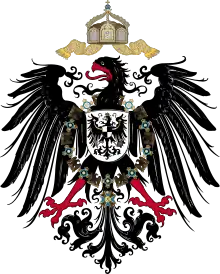Wilhelm, German Crown Prince
Wilhelm, German Crown Prince, Crown Prince of Prussia (Friedrich Wilhelm Victor August Ernst; 6 May 1882 – 20 July 1951) was the eldest child of the last Kaiser, Wilhelm II, German Emperor, and his consort Augusta Victoria of Schleswig-Holstein, and thus a great-grandson of Queen Victoria, and distant cousin to many British Royals, such as Queen Elizabeth ll. As Emperor Wilhelm's heir, he was the last Crown Prince of the German Empire and the Kingdom of Prussia, until the abolition of the monarchy.
| Wilhelm | |||||
|---|---|---|---|---|---|
| German Crown Prince Crown Prince of Prussia | |||||
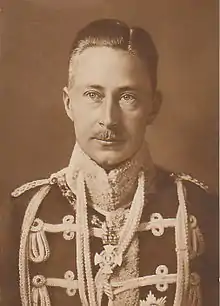 Crown Prince Wilhelm in 1914 | |||||
| Head of the House of Hohenzollern Prince of Prussia | |||||
| Tenure | 4 June 1941 – 20 July 1951 | ||||
| Predecessor | Wilhelm II | ||||
| Successor | Louis Ferdinand | ||||
| Born | 6 May 1882 Marmorpalais, Potsdam, Kingdom of Prussia, German Empire | ||||
| Died | 20 July 1951 (aged 69) Hechingen, Württemberg-Hohenzollern, West Germany | ||||
| Burial | 26 July 1951 Hohenzollern Castle, Württemberg-Hohenzollern, West Germany | ||||
| Spouse | |||||
| Issue | |||||
| |||||
| House | Hohenzollern | ||||
| Father | Wilhelm II, German Emperor | ||||
| Mother | Augusta Victoria of Schleswig-Holstein | ||||
| Religion | Lutheranism (Prussian United) | ||||
| Prussian Royalty |
| House of Hohenzollern |
|---|
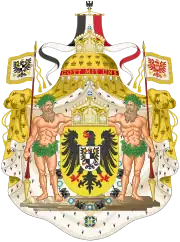 |
| Wilhelm II |
Wilhelm became crown prince at the age of six in 1888, when his grandfather Frederick III died and his father became emperor. He was crown prince for 30 years until the fall of the empire on 9 November 1918. During World War I, he commanded the 5th Army from 1914 to 1916 and was commander of the Army Group German Crown Prince for the remainder of the war. After his return to Germany in 1923, he fought the Weimar Republic and campaigned for the reintroduction of the monarchy in Germany. After his plans to become president had been blocked by his father, Wilhelm supported Adolf Hitler's rise to power, but when Wilhelm realised that Hitler had no intention of restoring the monarchy, their relationship cooled. Wilhelm became head of the House of Hohenzollern on 4 June 1941 following the death of his father and held the position until his own death on 20 July 1951.
Early life

Wilhelm was born on 6 May 1882 as the eldest son of the then Prince Wilhelm of Prussia, and his first wife, Princess Augusta Victoria of Schleswig-Holstein. He was born in the Marmorpalais of Potsdam in the Province of Brandenburg, where his parents resided until his father acceded to the throne. When he was born, his great-grandfather Wilhelm I was the German Emperor and his grandfather Crown Prince Frederick William was the heir apparent, making Wilhelm third in line to the throne.
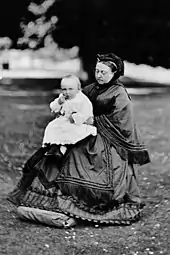
His birth sparked an argument between his parents and his grandmother Crown Princess Victoria. Before Wilhelm was born, his grandmother had expected to be asked to help find a nurse, but since her son did everything he could to snub her, the future Wilhelm II asked his aunt Princess Helena to help instead. His mother was hurt and his grandmother, Queen Victoria, who was the younger Wilhelm's great-grandmother, was furious.[1]
Prince Wilhelm would have five younger brothers: Prince Eitel Friedrich, Prince Adalbert, Prince August Wilhelm, Prince Oskar and Prince Joachim and one younger sister: Princess Viktoria Luise. He spent his childhood with his siblings at Marmorpalais and after his father's accession to the throne at the New Palace, also in Potsdam.
In the Year of the Three Emperors, when his great-grandfather and grandfather both died in 1888, his father became German Emperor, and six-year-old Wilhelm became the heir apparent to the German and Prussian thrones with the title of Kronprinz. He spent his school days with his brothers at the Prinzenhaus in Plön in his mother’s ancestral Schleswig-Holstein.
Wilhelm was a supporter of association football, then a relatively new sport in the country, donating a cup to the German Football Association in 1908 and thereby initiating the Kronprinzenpokal (now Länderpokal), the oldest cup competition in German football.[2] The German club BFC Preussen was also originally named BFC Friedrich Wilhelm in his honour.
In 1914, the Kaiser ordered the construction of Schloss Cecilienhof in Potsdam for Prince Wilhelm and his family which angered him. The Schloss was loosely inspired by Bidston Court in Birkenhead, England, resembling a Tudor manor.[3] Completed in 1917, it became the main residence for the Crown Prince for a time.
World War I
Wilhelm had been active in pushing German expansion, and sought a leading role on the outbreak of war. Despite being only thirty-two and having never commanded a unit larger than a regiment, the German Crown Prince was named commander of the 5th Army in August 1914, shortly after the outbreak of World War I. However, under the well-established Prussian/German General Staff model then in use, inexperienced nobles who were afforded commands of large army formations were always provided with (and expected to defer to the advice of) experienced chiefs of staff to assist them in their duties. As Emperor, Wilhelm's father instructed the Crown Prince to defer to the advice of his experienced chief of staff Konstantin Schmidt von Knobelsdorf.[4]
In October 1914 Wilhelm gave his first interview to a foreign correspondent and the first statement to the press made by a German noble since the outbreak of war.[5][6] He denied promoting military solutions to diplomatic problems, and said this in English:
Undoubtedly this is the most stupid, senseless and unnecessary war of modern times. It is a war not wanted by Germany, I can assure you, but it was forced on us, and the fact that we were so effectually prepared to defend ourselves is now being used as an argument to convince the world that we desired conflict.
From August 1915 onwards, Wilhelm was given the additional role as commander of the Army Group German Crown Prince. In 1916 his troops began the Verdun Offensive, a year-long effort to destroy the French armies that would end in failure. He personally ordered a naval gun to fire the first shot on 21 February 1916, starting the deadly battle.[7] Wilhelm relinquished command of the 5th Army in November of that year, but remained commander of the Army Group German Crown Prince for the rest of the war.
1918–34
After the outbreak of the German Revolution in 1918, both Emperor Wilhelm II and the Crown Prince signed the document of abdication. On 13 November, the former Crown Prince fled Germany, crossed into the Netherlands at Oudvroenhoven[8] and was later interned on the island of Wieringen (now part of the mainland), near Den Helder. In the autumn of 1921, Gustav Stresemann visited Wilhelm, and the former Crown Prince voiced an interest in returning to Germany, even as a private citizen. After Stresemann became chancellor in August 1923, Wilhelm was allowed to return after giving assurances that he would not engage in politics. He chose 9 November 1923 for this, which infuriated his father, who had not been informed about the plans of his son and who felt the historic date to be inappropriate.[9]: 11–12
In June 1926, a referendum on expropriating the former ruling Princes of Germany without compensation failed and as a consequence, the financial situation of the Hohenzollern family improved considerably. A settlement between the state and the family made Cecilienhof property of the state but granted a right of residence to Wilhelm and his wife Cecilie. This was limited in duration to three generations.[9]: 9–12 The family also kept the ownership of Monbijou Palace in Berlin, Oels Castle in Silesia, and Rheinsberg Palace until 1945.
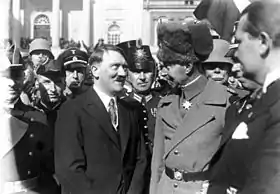
Wilhelm broke the promise he had made to Stresemann to stay out of politics. Adolf Hitler visited Wilhelm at Cecilienhof three times, in 1926, in 1933 (on the "Day of Potsdam") and in 1935. Wilhelm joined Der Stahlhelm, which merged in 1931 into the Harzburg Front, a right-wing organisation of those opposed to the democratic republic.[9]: 13
The former Crown Prince was reportedly interested in the idea of running for Reichspräsident as the right-wing candidate against Paul von Hindenburg in 1932, until his father (who privately supported Hindenburg) forbade him from acting on the idea. After his plans to become president had been blocked by his father, Wilhelm supported Hitler's rise to power.[9]: 13
1934–51

After the murder of his friend Kurt von Schleicher, the former Chancellor, in the Night of the Long Knives (1934), he withdrew from all political activities.
When Wilhelm realised that Hitler had no intention of restoring the monarchy, their relationship cooled. Upon his father's death in 1941, Wilhelm succeeded him as head of the House of Hohenzollern, the former German imperial dynasty. He was approached by those in the military and the diplomatic service who wanted to replace Hitler, but Wilhelm turned them down. After the ill-fated assassination attempt on 20 July 1944, Hitler nevertheless had Wilhelm placed under supervision by the Gestapo and had his home at Cecilienhof watched.[9]: 11–15
In January 1945, Wilhelm left Potsdam for Oberstdorf for a treatment of his gall and liver problems. His wife Cecilie fled in early February 1945 as the Red Army drew closer to Berlin, but they had been living apart for a long time. At the end of the war, Wilhelm's home, Cecilienhof, was seized by the Soviets.[9]: 15–16 The palace was subsequently used by the Allied Powers as the venue for the Potsdam Conference.[9]: 16
At the end of the war, Wilhelm was captured by French Moroccan troops in Baad, Austria, and was interned as a (World War I) war criminal. Transferred to Hechingen, Germany, he lived for a short time in Hohenzollern Castle under house arrest before moving to a small five-room house at Fürstenstraße 16 in Hechingen where he died on 20 July 1951, of a heart attack. Three days later, his opponent in the Battle of Verdun, Marshal Philippe Pétain, died in prison in France.[10]
Wilhelm and his wife are buried at Hohenzollern Castle.[11][12]
Family and children
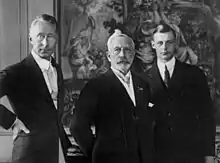
Wilhelm married Duchess Cecilie of Mecklenburg-Schwerin (20 September 1886 – 6 May 1954) in Berlin on 6 June 1905. After their marriage, the couple lived at the Crown Prince's Palace in Berlin in the winter and at the Marmorpalais in Potsdam, later on at Cecilienhof in Potsdam. Cecilie was the daughter of Frederick Francis III, Grand Duke of Mecklenburg-Schwerin (1851–1897) and his wife, Grand Duchess Anastasia Mikhailovna of Russia (1860–1922). Their eldest son, Prince Wilhelm of Prussia, was killed fighting for the German Army in France in 1940.
Their children are:
- Prince Wilhelm of Prussia (1906–1940), who renounced his succession rights in 1933 in order to marry Dorothea von Salviati, and had issue
- Louis Ferdinand, Prince of Prussia (1907–1994); married 1938 Grand Duchess Kira Kirillovna of Russia and had issue
- Prince Hubertus of Prussia (1909–1950); married 1941 Baroness Maria von Humboldt-Dachroeden, 1943 Princess Magdalena Reuss and had issue
- Prince Frederick of Prussia (1911–1966); married 1945 Lady Brigid Guinness and had issue:
- Princess Alexandrine of Prussia (1915–1980), called "Adini"
- Princess Cecilie Viktoria Anastasia Zita Thyra Adelheid of Prussia (1917–1975); married Clyde Kenneth Harris on 21 June 1949, and had issue
Honours
- Kingdom of Prussia:
- Knight of the Black Eagle, 6 May 1892;[15] with Collar
- Knight of the Royal Crown Order, 1st Class, 6 May 1892[15]
- Grand Commander's Cross of the Royal House Order of Hohenzollern, 6 May 1892[15]
- Grand Cross of the Red Eagle, with Crown, 12 June 1892[15]
- Iron Cross (1914), 2nd and 1st Classes
- Pour le Mérite (military), 22 August 1915; with Oak Leaves, 8 September 1916
- Hohenzollern: Cross of Honour of the Princely House Order of Hohenzollern, 1st Class with Swords
- Anhalt:
- Grand Cross of the Order of Albert the Bear, with Swords
- Friedrich Cross, 1st Class
- Baden:
- Knight of the House Order of Fidelity, 1900[16]
- Grand Cross of the Order of Berthold the First, 1900
- Kingdom of Bavaria:
- Knight of St. Hubert, 1900[17]
- Grand Cross of the Military Order of Max Joseph
- Duchy of Brunswick:
- Grand Cross of the Order of Henry the Lion, 1902;[18] with Swords
- War Merit Cross
- Ernestine duchies:
- Grand Cross of the Saxe-Ernestine House Order, with Swords
- Cross for Merit in War (Saxe-Meiningen)
- Free Hanseatic Cities: Hanseatic Crosses
- Hesse and by Rhine:
- Grand Cross of the Ludwig Order, 6 May 1900[19]
- General Honor Decoration
- Lippe:
- War Honor Cross for Heroic Deeds
- War Merit Cross
- Mecklenburg:
- Grand Cross of the Wendish Crown, with Crown in Ore
- Military Merit Cross, 1st Class (Schwerin)
- Oldenburg: Grand Cross of the Order of Duke Peter Friedrich Ludwig, with Golden Crown
- Reuss: War Merit Cross
- Saxe-Weimar-Eisenach: Grand Cross of the White Falcon, 1896;[20] with Swords
- Kingdom of Saxony:
- Knight of the Rue Crown, 1900[21]
- Commander of the Military Order of St. Henry, 1st Class
- Württemberg:
- Austria-Hungary: Grand Cross of the Royal Hungarian Order of St. Stephen, 1898[24]
- Belgium: Grand Cordon of the Order of Leopold
- Kingdom of Bulgaria: Grand Cross of St. Alexander
- Qing dynasty: Order of the Double Dragon, Class I Grade II
- Denmark: Knight of the Elephant, 6 May 1900[25]
- Greece: Grand Cross of the Redeemer
- Kingdom of Italy: Knight of the Annunciation, 13 April 1896[26]
- Empire of Japan: Grand Cordon of the Order of the Chrysanthemum, 19 September 1899[27]
- Monaco: Grand Cross of St. Charles, 15 January 1900[28]
- Netherlands: Grand Cross of the Netherlands Lion
- Norway: Grand Cross of St. Olav, with Collar, 15 December 1906[29]
- Ottoman Empire:
- Order of Distinction
- Order of Osmanieh, 1st Class in Diamonds
- Order of Glory
- Persia: Order of the Aqdas, 1st Class
- Kingdom of Portugal:
- Grand Cross of the Sash of the Two Orders
- Grand Cross of the Tower and Sword, with Collar
- Kingdom of Romania:
- Collar of the Order of Carol I
- Grand Cross of the Crown of Romania
- Kingdom of Serbia: Grand Cross of the White Eagle
- Siam: Knight of the Order of the Royal House of Chakri
- Spain: Knight of the Golden Fleece, January 1900[lower-alpha 1]
- Sweden: Knight of the Seraphim, 27 July 1888[33]
- United Kingdom of Great Britain and Ireland:
- Stranger Knight Companion of the Garter, 27 January 1901[34] (expelled in 1915)
- Recipient of the Royal Victorian Chain, June 1904[35] (expelled in 1915)
- Russian Empire:
Coat of arms

Ancestry
Notes
- Invested in Berlin on 2 March 1900 by the Duke of Veragua on behalf of King Alfonso XIII of Spain; the insignia was the same as those which were worn by the Emperor Wilhelm I)[14][30][31][32]
References
Citations
- Queen Victoria's Family, A Century of Photographs, Charlotte Zeepvat
- "Kick it like Kronprinz" (in German) Spiegel Online. Retrieved 11 June 2009
- "Hidden Wirral Myths & Legends Tours". www.facebook.com. Archived from the original on 26 February 2022. Retrieved 20 December 2017.
- Chief of Staff: Napoleonic Wars to World War I, David Zabecki
- Elter page 74
- Wiegand page 3
- Afflerbach, Holger. "Planning Total War? Falkenhayn and the Battle of Verdun, 1916". Cambridge University Press. Retrieved 8 June 2023.
- "From the Archives: The Ex-Kaiser and Family. Fugitives in Holland". The Hindu. 16 November 2018. ISSN 0971-751X. Retrieved 2 August 2019.
- Müller, Heike; Berndt, Harald (2006). Schloss Cecilienhof und die Konferenz von Potsdam 1945 (German). Stiftung Preussische Schlösser und Gärten. ISBN 3-910068-16-2.
- The Life of Crown Prince William by Klaus Jonas, 1961 pp. 214–30.
- "Preussen.de - Kronprinz Wilhelm". Archived from the original on 14 June 2012. Retrieved 21 June 2011.
- "Preussen.de - 50. Todestag der Kronprinzessin Cecilie". Archived from the original on 15 April 2016. Retrieved 21 June 2011.
- Handbuch über den Königlich Preußischen Hof und Staat (1918), Genealogy p.1
- Justus Perthes, Almanach de Gotha (1913) pp. 68–69
- "Königlich Preussische Ordensliste (supp.)", Preussische Ordens-Liste (in German), Berlin, 1: 5, 7, 66, 100, 1886 – via hathitrust.org
- Hof- und Staats-Handbuch des Großherzogtum Baden (1910) Großherzogliche Orden p. 40
- Hof- und Staats-Handbuch des Königreich Bayern (1908), "Königliche Orden" p. 9
- Hof- und Staatshandbuch des Herzogtums Braunschweig für das Jahr 1908. Braunschweig 1908. Meyer. p. 9
- "Ludewigs-orden", Großherzoglich Hessische Ordensliste (in German), Darmstadt: Staatsverlag, 1914, p. 6 – via hathitrust.org
- Staatshandbuch für das Großherzogtum Sachsen / Sachsen-Weimar-Eisenach Archived 6 September 2020 at the Wayback Machine (1900), "Großherzogliche Hausorden" p. 17
- Sachsen (1901). "Königlich Orden". Staatshandbuch für den Königreich Sachsen: 1901. Dresden: Heinrich. p. 5 – via hathitrust.org.
- "Königliche Orden", Hof- und Staats-Handbuch des Königreich Württemberg, Stuttgart: Landesamt, 1907, p. 31
- "Friedrich Wilhelm Viktor August Ernst, Kronprinz des Deutschen Reiches und von Preußen K.u.K.H." the Prussian Machine. Archived from the original on 17 June 2018. Retrieved 10 August 2020.
- ""A Szent István Rend tagjai"". Archived from the original on 22 December 2010.
- Jørgen Pedersen (2009). Riddere af Elefantordenen, 1559–2009 (in Danish). Syddansk Universitetsforlag. p. 468. ISBN 978-87-7674-434-2.
- Italia : Ministero dell'interno (1898). Calendario generale del Regno d'Italia. Unione tipografico-editrice. p. 54.
- 刑部芳則 (2017). 明治時代の勲章外交儀礼 (PDF) (in Japanese). 明治聖徳記念学会紀要. p. 149.
- Journal de Monaco
- Norway (1908), "Den kongelige norske Sanct Olavs Orden", Norges Statskalender (in Norwegian), p. 869-870, retrieved 17 September 2021
- "Court Circular". The Times. No. 36036. London. 11 January 1900. p. 7.
- "Court Circular". The Times. No. 36080. London. 3 March 1900. p. 11.
- Boettger, T. F. "Chevaliers de la Toisón d'Or - Knights of the Golden Fleece". La Confrérie Amicale. Retrieved 25 June 2019.
- Sveriges statskalender (in Swedish), 1925, p. 807, retrieved 6 January 2018 – via runeberg.org
- Shaw, Wm. A. (1906) The Knights of England, I, London, p. 71
- Shaw, p. 416
Literature
- Andreas Elter (April 2003), Die andere Front: Pressepolitik in den USKriegen des 20. Jahrhunderts (PDF) (in German), Cologne, archived from the original (PDF) on 18 July 2011, retrieved 5 April 2009
{{citation}}: CS1 maint: location missing publisher (link) - Karl Henry von Wiegand (1915), Current misconceptions about the war, New York: The Fatherland corporation, inc., retrieved 5 April 2009,
Copyright 1914, United Press ... 20 November
External links
- The memoirs of the Crown Prince of Germany
- The Life of Crown Prince Wilhelm
- Interview in Fox Movietone News 1932
- . Encyclopædia Britannica (12th ed.). 1922.
- Newspaper clippings about Wilhelm, German Crown Prince in the 20th Century Press Archives of the ZBW
- A review of his memoir from The New Republic (1922)
- His difficulty with his father: Current Literature Magazine, 1912
- The exiled Crown Prince in Holland: The Literary Digest, 1919
